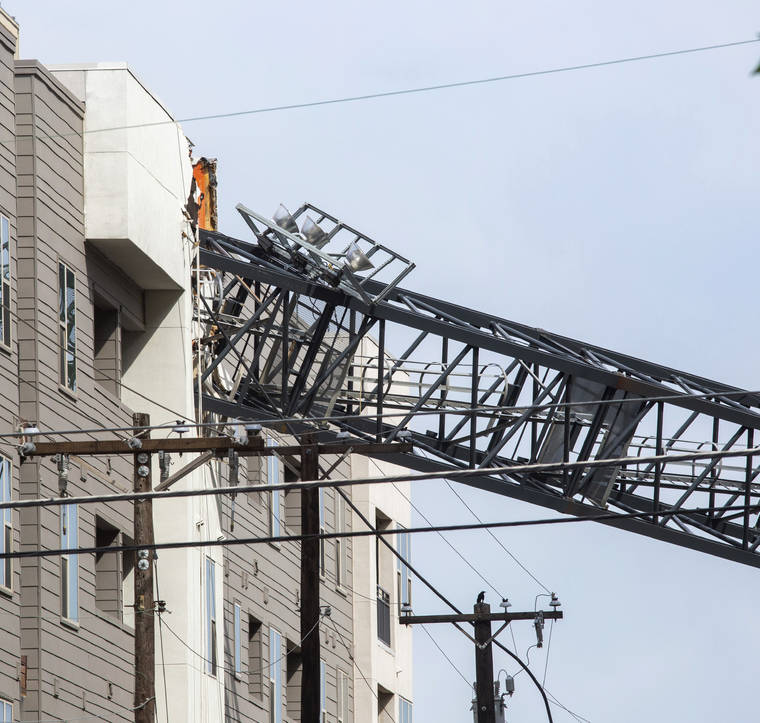DALLAS — Kayla McFall didn’t think much of the clouds rolling into Dallas as she relaxed in her grandparents’ pool. A native Texan, she’s used to storms blowing through and was still in the water when the sky darkened.
“It turned black and that’s when we started seeing the lightning and the extreme rain,” said McFall, 23. “But most of what we noticed was the wind was throwing things off roofs and bending the trees, which are probably 100-year-old oak trees that were almost sideways.”
Two days after the storm barreled through Dallas, large branches and whole trees can still be seen where they fell, hundreds of traffic signals remain out, and the work to restore power to thousands of people is ongoing.
Near downtown, a fallen crane that killed a woman and injured five other people in Sunday’s storm was still embedded Tuesday in the side of the Elan City Lights apartment complex. It’s unclear when the crane will be removed.
One tenant filed a negligence lawsuit seeking more than $1 million in damages from the owner of the buildings and the operator of the crane. The suit also seeks a court order to preserve the crane and the scene of its collapse.
McFall, who is staying with her grandparents while she recovers from a broken leg, said power in their home went out during the storm and only came back on around 2 a.m. Tuesday.
“I know a lot of people are probably upset that they didn’t get power back immediately but there’s not much you can do with one of these storms,” she said.
While severe weather is common in North Texas, the weekend storm stood out because it hit one of America’s most populous urban areas with such force.
“We had a lot of strong winds across the region, but Dallas really took the brunt of it,” National Weather Service meteorologist Daniel Huckaby said Tuesday.
Conditions were ripe for severe weather Sunday afternoon as storms that developed in Oklahoma moved south, slamming cold air into the warm, humid atmosphere over Texas, Huckaby said. The result was a downburst resulting in straight-line winds, including 71 mph (114 kph) gusts recorded at Dallas Love Field airport.
“In a city environment, where you have a lot of trees, you have shingles, then you get a lot of debris that’s picked up by the wind and that can result in additional damage,” he said.
At the peak, Oncor, the state’s largest electricity provider, reported more than 350,000 customers without power in the Dallas-Fort Worth area. That number was down to about 78,000 by Tuesday afternoon as crews worked around the clock.
Jen Myers, an Oncor spokeswoman and meteorologist, said the wind speeds Sunday were comparable to those seen in tropical storm or a weak tornado.
“The problem was that we saw this damage on almost a county-wide scale for Dallas County,” she said, adding that crews have had to clear out scores of fallen trees before they could re-string and energize power lines.
City spokeswoman Anastasia Reed said that as of early Tuesday morning, about 300 traffic lights were inoperable across Dallas and another 80 were flashing red. She also said cleanup crews are still trying to get a handle on everything that was hit.
“Our sanitation team has never seen this type of damage in recent years,” said Reed.
Huckaby said that severe thunderstorm warnings mean winds around 60 mph or higher are expected, and such warnings occur frequently in the area. But, he added, “At any given location, you can go many years without seeing a storm like this.”
When the lightning began Sunday, McFall and a friend retreated to the covered porch of her grandparents’ home in Farmers Branch. It has weathered hundreds of storms, she said, and offered a view of the yard’s old oaks and a ladder to trim them.
McFall said they began to question staying outside when “we started to see the large branches falling and the ladder flying a little bit.”


